
(a)
Interpretation:
The structural formula for
Concept Introduction:
In
In organic chemistry, reduction reaction is referred to the number
Alcohols undergo
Aldehyde undergoes oxidation to give carboxylic acid as the product while ketone does not undergo oxidation reaction.
(a)
Answer to Problem 16.45EP
The structural formula of the expected product is,
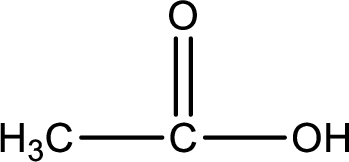
Explanation of Solution
Primary alcohol on oxidation gives aldehyde as intermediate product. This on further oxidation gives carboxylic acid as the product. The general scheme can be represented as shown below,

Given substance is,

This is a primary alcohol. The given compound is ethanol. Ethanol on oxidation gives ethanal as the intermediate product. The formed ethanal on oxidation gives ethanoic acid as the product. The complete scheme can be represented as shown below,

The carboxylic acid that is formed on oxidation of the given substance is ethanoic acid. The structural formula of ethanoic acid is given below,
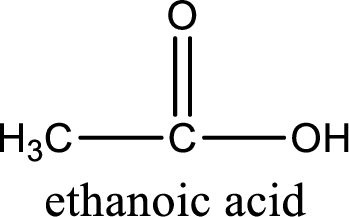
Structural formula of the carboxylic acid formed by the oxidation of given substance is drawn.
(b)
Interpretation:
The structural formula for carboxylic acid that is expected to be formed on oxidation of the given substance has to be drawn.
Concept Introduction:
In organic chemistry, oxidation reaction is referred to the number
In organic chemistry, reduction reaction is referred to the number
Alcohols undergo oxidation reaction and reduction reaction. This depends upon the number of hydrogen atoms that is bonded to the alpha carbon atom. Primary and secondary alcohol undergoes oxidation reaction while tertiary alcohol does not undergo oxidation reaction. Primary alcohols undergo oxidation to give aldehyde and carboxylic acid as product. Secondary alcohol undergoes oxidation to give ketone as the product.
Aldehyde undergoes oxidation to give carboxylic acid as the product while ketone does not undergo oxidation reaction.
Aromatic carboxylic acids are prepared from alkyl substituted benzenes.
(b)
Answer to Problem 16.45EP
The structural formula of the expected product is,
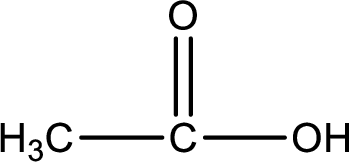
Explanation of Solution
Aldehyde on oxidation gives carboxylic acid as the product. The general scheme can be represented as shown below,

Given substance is,
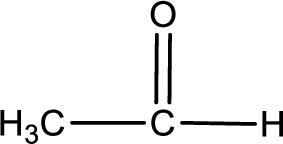
The given compound is ethanal and it is an aldehyde. Ethanal on oxidation gives ethanoic acid as the product. The complete scheme can be represented as shown below,

The carboxylic acid that is formed on oxidation of the given substance is ethanoic acid. The structural formula of ethanoic acid is given below,
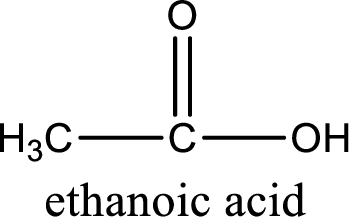
Structural formula of the carboxylic acid formed by the oxidation of given substance is drawn.
(c)
Interpretation:
The structural formula for carboxylic acid that is expected to be formed on oxidation of the given substance has to be drawn.
Concept Introduction:
In organic chemistry, oxidation reaction is referred to the number
In organic chemistry, reduction reaction is referred to the number
Alcohols undergo oxidation reaction and reduction reaction. This depends upon the number of hydrogen atoms that is bonded to the alpha carbon atom. Primary and secondary alcohol undergoes oxidation reaction while tertiary alcohol does not undergo oxidation reaction. Primary alcohols undergo oxidation to give aldehyde and carboxylic acid as product. Secondary alcohol undergoes oxidation to give ketone as the product.
Aldehyde undergoes oxidation to give carboxylic acid as the product while ketone does not undergo oxidation reaction.
Aromatic carboxylic acids are prepared from alkyl substituted benzenes.
(c)
Answer to Problem 16.45EP
The structural formula of the expected product is,

Explanation of Solution
Aldehyde on oxidation gives carboxylic acid as the product. The general scheme can be represented as shown below,

Given substance is,

The given compound is 3-methylpentanal and it is an aldehyde. 3-methylpentanal on oxidation gives 3-methylpentanoic acid as the product. The complete scheme can be represented as shown below,

The carboxylic acid that is formed on oxidation of the given substance is 3-methylpentanoic acid. The structural formula of 3-methylpentanoic acid is given below,
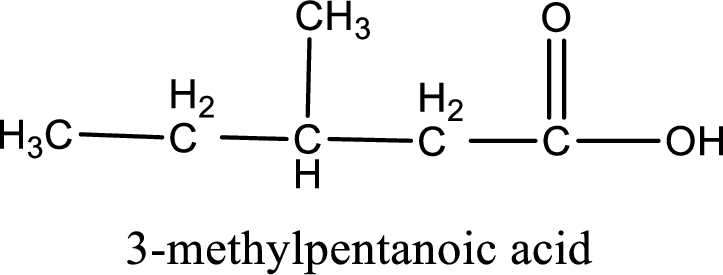
Structural formula of the carboxylic acid formed by the oxidation of given substance is drawn.
(d)
Interpretation:
The structural formula for carboxylic acid that is expected to be formed on oxidation of the given substance has to be drawn.
Concept Introduction:
In organic chemistry, oxidation reaction is referred to the number
In organic chemistry, reduction reaction is referred to the number
Alcohols undergo oxidation reaction and reduction reaction. This depends upon the number of hydrogen atoms that is bonded to the alpha carbon atom. Primary and secondary alcohol undergoes oxidation reaction while tertiary alcohol does not undergo oxidation reaction. Primary alcohols undergo oxidation to give aldehyde and carboxylic acid as product. Secondary alcohol undergoes oxidation to give ketone as the product.
Aldehyde undergoes oxidation to give carboxylic acid as the product while ketone does not undergo oxidation reaction.
Aromatic carboxylic acids are prepared from alkyl substituted benzenes.
(d)
Answer to Problem 16.45EP
The structural formula of the expected product is,
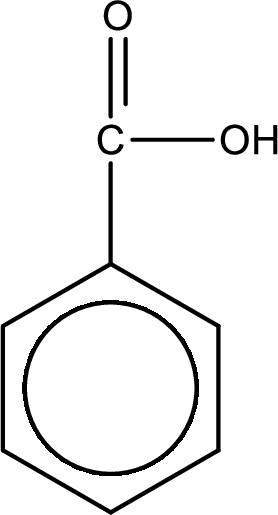
Explanation of Solution
Given substance is,

Oxidation of the alkyl side chain in a benzene derivative leads to the formation of aromatic acids. All the carbon atoms in alkyl group are lost except the one that is attached to the ring. The one carbon that is attached to the ring becomes a part of carboxyl

The product formed is benzoic acid.
Structural formula of the carboxylic acid formed by the oxidation of given substance is drawn.
Want to see more full solutions like this?
Chapter 16 Solutions
General, Organic, and Biological Chemistry
- Reaction A 0,0arrow_forwardpresented by Morillon Leaning Predict the organic product for the min кусур HSC Adithane carved arnown to come than that to the condon slchroruis in acid in in aquishri with ноюarrow_forward6.15PM Sun Mar 30 K Draw the major product of this reaction. Include any relevant stereochemistry. Ignore inorganic byproducts. Problem 1 of O H [PhзPCH2CH3]*C|¯ NaH Drawing > Q Atoms, Bonds and Draw or tap a nearrow_forward
- 8:17 PM Sun Mar 30 Draw the major product of this reaction. Ignore inorganic byproducts. HSCH2CH2CH2SH, BF3 Probler Drawing Ato Bonds Clarrow_forwardpresented by Mr L How the coprion. (Il Done in no wraction, dew the starting redential) доarrow_forward8:16 PM Sun Mar 30 K Draw the major product of this reaction. Ignore inorganic byproducts. Proble 1. CH3MgBr 2. H3O+ F Drawingarrow_forward
- о но оarrow_forwardName the major organic product of the following action of 4-chloro-4-methyl-1-pentanol in neutral pollution 10+ Now the product. The product has a molecular formula f b. In a singly hain, the starting, material again converts into a secule with the molecular kormula CIO. but with comply Draw the major organic structure inhalationarrow_forwardMacmillan Learning Alcohols can be oxidized by chromic acid derivatives. One such reagent is pyridinium chlorochromate, (C,H,NH*)(CICTO3), commonly known as PCC. Draw the proposed (neutral) intermediate and the organic product in the oxidation of 1-butanol by PCC when carried out in an anhydrous solvent such as CH₂C₁₂. PCC Intermediate OH CH2Cl2 Draw the intermediate. Select Draw Templates More с H Cr о Product Draw the product. Erase Select Draw Templates More H о Erasearrow_forward
- If I have 1-bromopropene, to obtain compound A, I have to add NaOH and another compound. Indicate which compound that would be. A C6H5 CH3arrow_forwardProvide the reagents for the following reactions.arrow_forwardIf I have 1-bromopropene, to obtain compound Z, I have to add two compounds A1 and A2. Indicate which compounds are needed. P(C6H5)3arrow_forward
 Organic And Biological ChemistryChemistryISBN:9781305081079Author:STOKER, H. Stephen (howard Stephen)Publisher:Cengage Learning,
Organic And Biological ChemistryChemistryISBN:9781305081079Author:STOKER, H. Stephen (howard Stephen)Publisher:Cengage Learning, General, Organic, and Biological ChemistryChemistryISBN:9781285853918Author:H. Stephen StokerPublisher:Cengage Learning
General, Organic, and Biological ChemistryChemistryISBN:9781285853918Author:H. Stephen StokerPublisher:Cengage Learning Chemistry for Today: General, Organic, and Bioche...ChemistryISBN:9781305960060Author:Spencer L. Seager, Michael R. Slabaugh, Maren S. HansenPublisher:Cengage Learning
Chemistry for Today: General, Organic, and Bioche...ChemistryISBN:9781305960060Author:Spencer L. Seager, Michael R. Slabaugh, Maren S. HansenPublisher:Cengage Learning
 World of Chemistry, 3rd editionChemistryISBN:9781133109655Author:Steven S. Zumdahl, Susan L. Zumdahl, Donald J. DeCostePublisher:Brooks / Cole / Cengage Learning
World of Chemistry, 3rd editionChemistryISBN:9781133109655Author:Steven S. Zumdahl, Susan L. Zumdahl, Donald J. DeCostePublisher:Brooks / Cole / Cengage Learning General Chemistry - Standalone book (MindTap Cour...ChemistryISBN:9781305580343Author:Steven D. Gammon, Ebbing, Darrell Ebbing, Steven D., Darrell; Gammon, Darrell Ebbing; Steven D. Gammon, Darrell D.; Gammon, Ebbing; Steven D. Gammon; DarrellPublisher:Cengage Learning
General Chemistry - Standalone book (MindTap Cour...ChemistryISBN:9781305580343Author:Steven D. Gammon, Ebbing, Darrell Ebbing, Steven D., Darrell; Gammon, Darrell Ebbing; Steven D. Gammon, Darrell D.; Gammon, Ebbing; Steven D. Gammon; DarrellPublisher:Cengage Learning





